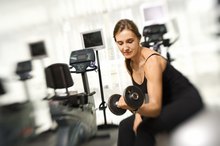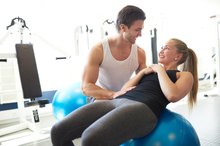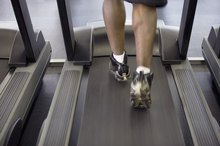Why Do I Feel Nauseous After Pilates?
Post-Pilates nausea is uncommon, but not unheard of. While no peer-reviewed studies address the Pilates and nausea problem directly, research regarding nausea after other types of exercise offers insight into this issue. Numerous conditions, such as room temperature, and high or low blood pressure, may cause nausea after a Pilates class. Consult your doctor if you frequently feel nauseous after taking any exercise class.
Room Temperature
Pilates falls into the mind/body category of fitness methods. If you belong to a commercial fitness center, there's a good chance that your gym has a designated mind/body classroom. The good news is that this room usually has a spot in the quieter section of the gym. The bad news is that your Pilates class may take place after a hot yoga session. While Pilates and yoga have some similarities, yoga involves holding postures and breathing in between positions, and Pilates involves continuous movement. Some "hot yoga" class instructors set the room temperature above 100 degrees Fahrenheit. Constant movement at these temperatures may cause heatstroke, whose symptoms include nausea and dizziness.
- Pilates falls into the mind/body category of fitness methods.
- The bad news is that your Pilates class may take place after a hot yoga session.
Low Blood Pressure
I Have a Stomach Ache While Lifting Weights
Learn More
For most people, low blood pressure is not a problem, except when it causes symptoms such as nausea and dizziness. Most Pilates mat classes include exercises performed in the supine, side-lying, seated or prone position. The end of the class requires a slow transition to the standing position, but time constraints often cause people to jump up and run to the locker room. This does not cause problems for people with normal blood pressure, but low blood pressure may cause nausea and dizziness under these circumstances.
- For most people, low blood pressure is not a problem, except when it causes symptoms such as nausea and dizziness.
Motion Sickness
Motion sickness, clinically called benign positional vertigo, may cause post-Pilates nausea 1. This condition often occurs when your eyes fall out of sync with the sensory receptors in your muscles, joints and ligaments. Moira Stott of Stott Pilates advises students to prevent motion sickness by keeping their gaze in the direction of the line of movement. When performing a Pilates abdominal flexion exercise, for example, nod your head in preparation, and keep your gaze focused on your stomach. Recent ear or upper respiratory infections may also make you more susceptible to benign positional vertigo 1.
Food and Water
What Causes Vomiting When Running
Learn More
All movements, even supposedly gentle exercise techniques, require adequate fuel and hydration. Most Pilates enthusiasts know that even Pilates mat classes are not as gentle as they look. Time your food and water consumption before a class. An empty stomach or dehydration may cause nausea after Pilates class, as will an overly full stomach. Avoid high-fat meals with heavy, greasy sauces before class, and stick to complex carbohydrates such as whole grain breads or vegetables. Keep a bottle of water available for ongoing hydration.
- All movements, even supposedly gentle exercise techniques, require adequate fuel and hydration.
Related Articles
References
Writer Bio
Martin Booe is a health, fitness and wellness writer who lives in Los Angeles. He is currently collaborating on a book about digital addiction to be published in the UK this December.









